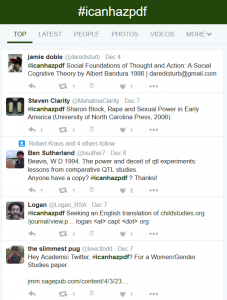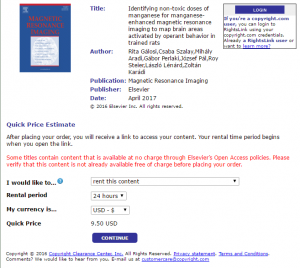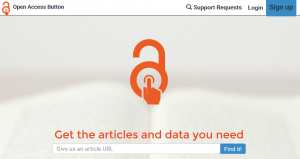The current state of academic publishing is something we should all be thinking about
,
given that it’s a means of disseminating the knowledge generated by
academic research — much of which is publicly funded yet inaccessible to
the public. Publishing is also significant because of the key role it
plays in academic careers, where it serves as a gatekeeping mechanism.
Changes to academic publishing both reflect, and contribute to,
broader trends within academe; and they point to a range of critical
questions. Within the contexts and constraints of established
institutions and practices, what possibilities are opened up by recent
technologies and new organisational forms? How could publishing change
in (and differ across) the various academic areas and fields? How might
the increased competition for academic jobs, and the smaller proportion
of scholars with permanent positions, affect publishing and associated
labour? Can we maintain the accessibility and quality of publications
and the process of peer review while also ensuring compensation for the
work involved? What about digital publication and circulation – will
(paywalled) journal publishing eventually become obsolete?
This post explores some of those questions by way of an interview with
Professor Martin Paul Eve,
who is an all-round expert on, and active promoter of, open access
academic publishing. Professor Eve is chair of literature, technology
and publishing at Birkbeck, University of London, and the author of
Open Access and the Humanities: Contexts, Controversies and the Future.
Among many other things,
Professor Eve also gave evidence to the U.K. government’s business,
innovation and skills committee inquiry into open access, in 2013, and
with Dr. Caroline Edwards he is a co-founder of the
Open Library of the Humanities
(OLH), in which 16 Canadian institutions are already participating. The
following interview focuses on OLH and on the issues of access to
knowledge (in the form of peer-reviewed research) that underlie its
creation.

Dr. Martin Paul Eve.
could you provide a bit of a description of what it does and how it
works?
The Open Library of Humanities is a charitable, not-for-profit, open
access publisher of peer-reviewed humanities research material that I
co-founded with my colleague Dr. Caroline Edwards. The OLH currently
publishes (or financially supports) 18 journals and in our first year of
operation we made over 900 scholarly articles available at no charge to
readers.
Unlike other open access publishers, though, the OLH has a different
economic model. In a move to abandon subscriptions so that there is no
cost to read academic research work on the internet, many publishers are
turning to so-called Article Processing Charges (APCs); a fee to be
paid by the author, their institutions, or their funders. This is not a
fee to bypass peer review, but rather a fee to cover the publisher’s
labour (and surplus/profits). It is a substitution for subscription
revenue.
In our disciplines, however, it is far harder to see where this money
will come from (Taylor & Francis for instance has an APC of about
$2,000). Our model works differently. Instead of asking authors or
funders to pay when work is accepted, we have over 200 libraries paying
us an annual amount that
looks like a subscription. The change
though is that with the money from that fee, we make all our work openly
available. So yes, even if libraries don’t pay, their academics can
submit and read the work. We know, though, that this is not how
libraries and universities think. Universities should exist for the good
of society, not for exclusionary gain. The fact that so many libraries
have supported this non-classical economic model so that research work
can be broadly accessible is the proof.
You mentioned in another interview that this idea was
coalescing at the end of 2012/early 2013, as part a broader discussion
about scholarly publishing; three years later, OLH has been running for
over a year and has participants at more than 200 institutions. How did
you get started with a project of this size, let alone get it running
within such a short period — and especially when the process involves so
much consultation and buy-in from so many different groups?
I often wonder to myself: were I able to go back in time and warn my
previous self how much work and how difficult the whole thing would be,
would I still do it? I like to think the answer is “yes” because I
believe in higher education and that research work should be accessible
to anyone who is interested. But it is hard to say when speaking in such
hypothetical terms.
We began by simply floating the idea online of creating something a
bit like the Public Library of Science (PLOS) in the humanities. When I
put up an initial web page, we had over 200 emails overnight from
interested parties, so the demand seemed clear. We also realised early
on, though, that we’d need to play the prestige game very carefully. The
whole academic system of certification and accreditation is built on a
symbolic economy of prestige. This makes it very hard for new players to
enter the arena since they do not yet have a track record and many
academics fear that they will lose out on career progression (or even
jobs) if they do not play the game that hiring panels expect.
That said, some early supporters gave us a boost. We’re immensely
grateful to David Armitage, for instance, the Lloyd C. Blankfein
Professor of History at Harvard, who said of the OLH that “there is
hardly a more important project in train for scholarship in the
humanities today.” We also assembled committees of high-profile
academics to ascertain what they felt would be needed to make an idea
like OLH work. And we listened and we structured the platform around the
advice we received. For instance, the first version of the OLH was
going to be based on Article Processing Charges, as is PLOS. But the
committees baulked at this and so we had to design a new, untested model
for the ongoing economic support of academic journals. We also had to
balance the desires of hard-line open access enthusiasts against a
distaste for full open licensing among some of our disciplinary
communities. We had to handle the more radical thinking of some
technologists against the traditions of the humanities and the need to
ensure their continuity.
We also had to work out how to establish and govern a charitable
company; something with which I was totally unacquainted before we began
the enterprise (I feel I should here mis-cite Bones McCoy from
Star Trek:
“Damn it Jim, I’m an academic not a businessman”). Generous support
from the University of Lincoln; Birkbeck, University of London; and the
Andrew W. Mellon Foundation made this all possible. Indeed, we spent
those setup years travelling the world and telling academics,
librarians, societies, and publishers what we wanted to do and gaining
their trust, support, and feedback.
As a result we managed to go from rough idea at the end of 2012/2013
to a platform launch in September 2015. That’s not a bad timescale but
we did nonetheless receive criticism that it was too slow (one person
wrote, paraphrasing, that “the OLH has to-date not published a single
article”). And this is the dilemma. If you spend time planning things,
people criticize you for taking too long. If you rush into it, people
criticize you for not planning.
You’ve said that “Cooperation can solve the budget crisis in
scholarly communications where competition has failed us.” How does the
OLH model (and maybe open access overall) function as cooperative?
The term “cooperative” has different meanings in different contexts.
There’s a formal organizational structure called a “cooperative” that
refers to co-ownership of an enterprise by its employees. I didn’t quite
mean that but rather the underlying principle of working in concert
rather than relying on free-market competition.
To explain this, I have to give a brief background to the economics
of scholarly communications. Since 1986, according to ARL statistics,
the cost for each institution of subscribing to the full range of
journals that its academics and students require has risen by an
estimated 300 percent
above inflation. There are many reasons
for this. One is that the mass expansion of higher education has led to
greater publication volume. However, there is also the matter of vast
profits and quasi-monopolistic practices among large publishers.
Indeed, the largest publisher of scientific journals, Elsevier (RELX
Group), makes an approximate 35 percent profit. As I’ve pointed out
before, this is double the profit rate of oil and pharmaceutical
companies. Clearly – despite the efforts of Elsevier’s supporters to
equate such exorbitant profits with charitable surpluses (the most
frequent comeback I get to the preceding fact is: “even OLH has to make a
surplus”… Yes, but it’s hardly the same as a 35 percent profit!) –
something is going very wrong with the market here.
So why hasn’t free-market competition solved this problem? Well,
goods in the scholarly communications market (academic journal articles
and books, for example) are not substitutable goods. When an academic
needs to read a specific piece of work,
only that article or
book will do because the content is, usually as a precondition, unique
and novel. Companies like Elsevier who own the copyright on up to 40
percent of the supply in certain disciplinary spaces know that academics
need the work they possess. So there is no competition in this sense;
unique non-substitutable goods that are required for academic work are
for sale at whatever rate the owner demands.
Open access and article processing charges do not necessarily resolve
the crisis of library budgets, though. Hybrid open access refers to the
conditions where publishers run a journal as a subscription entity but
allow authors to pay a charge to make a specific article openly
available. The problem here is that, without offsetting of the amount
paid, the charges just mount and mount on top of subscription revenue.
Because the people paying – the library – are not the same as the people
submitting and reading – the academics – there is little sensitivity to
such pricing from those who have the most agency within the system.
For me, this all amounts to a failure of scholarly communications
practices to act like a market. And perhaps we don’t want it to be one.
This is why I proposed cooperation as a way in which library acquisition
staff can escape the failure of market competition. By pooling
resources – as does the OLH by gathering small amounts from a moderate
number of libraries – on a not-for-profit basis, we see a better use of
budget than market competition was able to deliver. Indeed, across our
200 supporting institutions, we estimate that the approximate average
paid was $1,000. This works out at just $55 per journal per institution.
Alternatively, this is $1.10 per institution per article (many of the
articles in our first year comprised cheaper back-content import
though). However, if we flip this around and focus on the 118,686 unique
users who visited article pages in our first year, this is just $0.008
per institution per reader. And this gets cheaper as more institutions
join.
That’s why I advocated for a form of cooperation. Do not focus on the
problem of “free riders” and the fact that even if one pays, others get
access for nothing. Instead focus on what such non-classical economic
thinking can actually deliver.
Some have described the academic publishing industry as a “racket”,
running on huge amounts of free labour while charging academic
institutions, and individual researchers, exorbitant fees to read papers
— and subsequently enjoying huge profit margins. How much labour do
publishers actually perform and can they really justify charging as much
as they do?
First, there’s a bit of a problem with referring to “publishers” as a
homogeneous group. It spans the giants of Elsevier, Taylor &
Francis, Wiley, Oxford University Press down to tiny university presses
that barely break even. It runs from for-profits through charities.
Publishers are many things.
Publishers perform, though, a variety of labour functions. There’s a
(pretty eked-out) list of 96 things publishers do on the (pretty
conservative)
Scholarly Kitchen blog.
However, I think that the labour function is mostly coordinating peer
review, platform maintenance, typesetting, copyediting, proofreading,
digital preservation, legal, accountancy, marketing (which is partly
dissemination and partly business-model based) and general business
overheads. List cultivation and actual editorial input might be placed
here for some humanities disciplines, but whether this is a needed
function or part of a business strategy remains hazy for me. Running OLH
is a full-time day job for me and my colleagues at the moment. I tend
to get up early and do my academic research reading and writing from
6:30 a.m. until 10 a.m. before then doing a full day of OLH work.
Publishers undoubtedly do things that we want and continue to
require. However, I do not see why (as above) this should legitimatize
extortionate levels of profit so that we can exclude others from reading
research. One recent criticism I saw, for instance, was
Daniel Allington comparing scholarly communications to a bar
(as the old jokes always go) in a Twitter reply and deriding OA
advocates for calling publishers “parasites.” Yet, Marx himself noted
that “capital is dead labour” describing it as “vampire-like.” To call
the profit-rates of mega companies a “racket” or “parasitical” is not to
deride the labour of their employees or even the desired labour
function. It is metaphorically to label such huge companies as a rentier
group who use a variety of canny business strategies to feed off
universities and achieve market dominance. Taylor & Francis, for
instance, wrote in
their annual shareholder report
that their revenue stream was “dominated by subscription assets with
high renewal rates, where customers generally pay us twelve months in
advance. This provides strong visibility on revenue and allows the
businesses to essentially fund themselves, with minimal external capital
required.” They believe that “it is a uniquely attractive mode.”
One problem I see with the “Gold” OA model (explanation provided here)
when author fees are involved, is that there’s an assumption that
everyone publishing is affiliated with an institution and has access to
institutional funding that can cover the cost. Many of those who want to
publish are early career academics who may not have institutional
support. To me it seems that the author-facing charges would inhibit
access to publishing for a lot of scholars. OLH has avoided this by
rejecting author fees; how does its funding model work? Would it be a
viable option beyond the humanities?
Yes, I agree with your assessment here. I think this comes from the
fact that many OA models have developed in the sciences, where much
research work requires (and has) external funding that can budget for
such charges. This is not universally the case, though. (And one
criticism of OA is the fact that it grew from the sciences and is being
applied elsewhere. I have long argued, though, that the benefits to the
humanities of open research work are as great as those for the sciences;
we just need a different implementation strategy.)
As above, OLH operates on a consortial funding model. Many libraries
pay a relatively small amount into our central budget. We then make work
openly available. There is precedent for this in
arXiv,
Knowledge Unlatched, and, to a lesser extent, the
SCOAP3
purchasing consortium. It’s not a totally new idea. But it is the first
time that a publisher has run its entire business model on this for
front-matter serials publication.
The key part of what we’re doing, though, is participating in schemes
to “flip” journals that were subscription to an open access model. In
some cases, this involves an editorial board leaving a publisher – as
did the editorial board of
Lingua – while in others it involves
us working with the university press to fund their journal; as with the
University of Wales Press. We currently have two other university
presses discussing flipping more substantial portions of their lists
through the OLH model.
Certainly, though, there is no reason why what we’ve done could not
be expanded beyond the disciplines in which we operate. However, we’d
need to grow more rapidly and have more initial capacity if we were to
run an Open Library of Science, for instance. Indeed, we’d need upfront
funder investment to expand our consortium size at a swifter rate and to
a higher level than we currently plan.
A lot of the discussion about “openness” has been about the
sciences; your area is the humanities (and that’s the topic of your
book). I have to apologise for not having read it yet — but what would
you say are the specific challenges for the humanities (and perhaps for
the social sciences as well) when it comes to open access scholarly
publishing? How might those compare to what’s going on in STEM areas?
There are several challenges that are more pronounced in the
humanities so I’ll just touch on a few here: the importance and
prominence of monographs; the inclusion of third-party copyrighted
material as an integral component of work (say in art history); and the
different funding climate.
Monographs are tricky. They cost a lot more, they often have trade
crossover, and they sometimes gain a broader audience by being available
for sale in print. Certainly, I personally do not want to read 80,000
words on a screen for cover-to-cover reading. But that doesn’t mean that
there isn’t merit in having books openly available; particularly as
these can cost $100 or so per copy. In any case, a task force has been
set up in the U.K. to plan a transition scheme to enable OA monographs
by the mid-2020s. I’ve also sketched out some
initial challenges in this space on my blog.
The third-party copyright matter is also a bit of sticking point.
Without such inclusions work is often severely impoverished. When
analysing images, if the image is not there, the evidence to back up the
point is not clear; this is also an access issue. Getting clearance for
images for unlimited online dissemination can be tough since galleries,
libraries, archives, and museums are often not accustomed (yet) to such
requests.
Finally, as above, the transition to OA in the humanities looks
harder, since it is unclear whence the funding for APCs will emerge.
Opponents of OA also argue that the journal costs in the humanities for
subscriptions are lower than in the sciences, implying that they think
the fuss isn’t worth it. Yet I have never worked at an institution that
has subscriptions to every journal that I need for my research work, on
the grounds of cost, so I’m not buying this.
None of this is to say that there aren’t specific challenges for the
humanities but I prefer to think of the opportunities. Imagine a world
where humanistic knowledge and inquiry – that is, research work about
culture and humans – was available freely to every human on the planet.
Is that not a goal worthy of overcoming a few hurdles?
What do you think are the most salient critiques of open access for academic publishing?
There are lots of very poor attacks on OA that I am tired of
defending but the ones that are most salient seem to me to be the
pragmatic critiques. How are we actually going to do this? How can we
achieve that universal library for anyone who is interested in reading,
without discriminating on their ability to pay? Usually, these critiques
don’t come with answers. They point out the dire economic circumstances
for the humanities, the difficulties of freeing subscription revenue
etc. These are useful when they provide models to warn us of the
challenges and dangers. But I am also interested in how we move from
theory to practice. My book on OA (itself open access from Cambridge
University Press) is designed as a theoretical basis on which the OLH or
others can operate. It’s not a sales pitch for the model it’s just that
I am not content with merely philosophising about the world; the point,
after all, is to change it.
So much about the academic profession is shifting; I know
this is always the case — and we are always acutely aware of our own
time, particularly when it comes to technology and its effects. Given
the nature of academic institutions, what changes to scholarly
publishing (as knowledge dissemination) do you think might unfold within
the span of your career?
This is the kind of question that can come back to haunt the
interviewee and I’m very wary of such futurology! It’s also worth noting
that things move at a
glacial pace within the academy.
However, things I see happening already include a desire for open
access among early career humanists. If at least some of them want it,
then it is likely to happen. Data sharing in various ways is also on the
up. I hope that we will see books available openly online for the good
of all. I also hope that text and data mining provisions through the
availability of semantically rich research articles can help us to more
accurately understand the scholarly web and its contents.













 Lavina
Lavina


